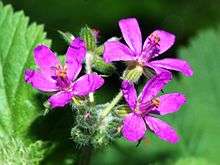Erodium
| Erodium | |
|---|---|
 | |
| Erodium malacoides | |
| Scientific classification | |
| Kingdom: | Plantae |
| (unranked): | Angiosperms |
| (unranked): | Eudicots |
| (unranked): | Rosids |
| Order: | Geraniales |
| Family: | Geraniaceae |
| Genus: | Erodium Aiton |
| Species | |
|
See text. | |
Erodium is a genus of flowering plants in the botanical family Geraniaceae. The genus includes about 60 species, native to North Africa, Indomalaya, The Middle East and Australia. They are perennials, annuals or subshrubs, with five-petalled flowers in shades of white, pink and purple, that strongly resemble the better-known Geranium (cranesbill).[1] American species are known as filarees or heron's bill, whereas Eurasian ones are usually called storksbills in English.
Taxonomy
Carl Linnaeus grouped in the same genus (Geranium) the three similar genera Erodium, Geranium, and Pelargonium. The distinction between them was made by Charles Louis L'Héritier de Brutelle based on the number of stamens or anthers: five for Erodium, seven for Pelargonium, and ten for Geranium. However, the three genera have the same characteristics in regard to their fruit, which resemble long bird beaks. That characteristic is the basis for the names: Geranium evokes the crane (Greek geranos), Pelargonium the stork (pelargos), and Erodium the heron (erodios).
Cultivation
In cultivation, erodiums are usually seen in rockeries or alpine gardens.[1]
The hybrid cultivar E. × variabile 'Roseum' (E. corsicum × E. reichardii), a compact, spreading perennial with rose-pink flowers in summer, has gained the Royal Horticultural Society's Award of Garden Merit.[2]
Ecology
Erodium species are used as food plants by the larvae of some Lepidoptera species including Pasture Day Moth.
Species
|
|
- This list is incomplete; you can help by expanding it.
See Also
References
- 1 2 RHS A-Z encyclopedia of garden plants. United Kingdom: Dorling Kindersley. 2008. p. 1136. ISBN 1405332964.
- ↑ "Erodium × variabile 'Roseum'". Royal Horticultural Society. Retrieved 26 July 2013.
- Pink, A. (2004). Gardening for the Million. Project Gutenberg Literary Archive Foundation.